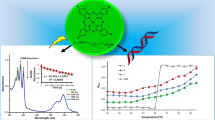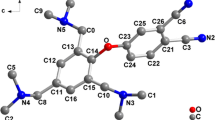Abstract
In the present work, we propose the synthesis of novel nicotinamide subsituted phthlocyanine photosensitizer (PS) and characterized by FTIR, UV–visible, H-NMR and MALDI Toff spectroscopy. Nicotinamide plays a vital rule in the central nervous system and its potential as a therapeutic for neurodegenerative disease. Nicotinamide substituted PS (3) efficiently produced ROS via type-1 process as measured by DCF assay. We observed that our PS after red light illumination (22 J/cm2) killed gram positive S. aureus upto 3 log reduction. Furher the addition of Potassium Iodide (100 mM) significantly potentiated PS at lower concentrations and enhanced the bacterial killing upto 6 log reduction against the S. aureus. We further found that the synergistic effect of PS and KI also eradicated the gram negative E. coli strain at lower concentraion of PS and found to killed E. coli upto 5 log reduction under the red light illumination at 22 J/cm2 of light dose. The conjugation of such biologically important form of vitamin B3 with PS would be a great addition and could pav the way for the novel photodynamic agent in the treatement of cancer and infectious diseases.
Graphic abstract
A new symmetrical Nicotinamide tetrasubstituted zinc phthalocyanine (3) was synthesized. Upon addition of potassium Iodide with PS, the PS exhibited significant photodynamic activity with 5-6 logs reduction in bacterial load was achieved.








Similar content being viewed by others
References
Baron ED, Malbasa CL, Domingo DS, Fu P, Miller JD, Hanneman KK, Hsia AH, Oleinick NL, Collusi VC, Cooper KD (2010) Silicon phthalocyanine (Pc 4) photodynamic therapy is a safe modality for cutaneous neoplasms: results of a phase 1 clinical trial. Lasers Surg Med 42:888–895. https://doi.org/10.1002/lsm.20984
Günsel A, Kocabas K, Bilgicli AT, Guney S, Kandaz M (2016) Synthesis, photophysical and electrochemical properties of water–soluble phthalocyanines bearing 8-hydroxyquinoline-5- sulfonicacid derivatives. J Lumin 176:387–396. https://doi.org/10.1016/j.jlumin.2016.03.036
Hamblin MR, Hassan T (2004) Photodynamic therapy: a new antimicrobial approach to infectious disease? Photochem Photobiol Sci 3:436–450. https://doi.org/10.1039/b311900a
Hamblin MR, Abraham H (2018) Inorganic salts and antimicrobial photodynamic therapy:mechanistic conundrums? Molecules. 23:3190. doi.https://doi.org/10.3390/molecules23123190
Huang YY, Wintner A, Seed PC, Brauns T, Gelfand JA, Hamblin MR (2018) Antimicrobial photodynamic therapy mediated by methylene blue and potassium iodide to treat urinary tract infection in a female rat model. Sci Rep 8:7257. https://doi.org/10.1038/s41598-018-25365-0
Jori G, Fabris C, Sonchin M, Ferro S, Coppelotti O, Dei D, Fantetti L, Chiti C, Roncocci G (2006) Photodynamic therapy in the treatment of microbial infections: basic principles and perspective applications. Lasers Surg Med. 38 468–481. https://doi.org/10.1002/lsm.20361
Ke MR, Eastel JM, Ngai KK, Cheung YY, Chan PK, Hui M, Ng DK, Lo PC (2014) Photodynamic inactivation of bacteria and viruses using two monosubstituted zinc (II) phthalocyanines. Eur J Med Chem 84:278–283. https://doi.org/10.1016/j.ejmech.2014.07.022
Kussovski V, Mantareva V, Angelov I, Orozova P, Wohrle D, Schnurpfeil G, Borisova E, Avramov L (2009) Photodynamic inactivation of Aeromonas hydrophila by cationic phthalocyanines with different hydrophobicity. FEMS Microbiol Lett 294:133–140. https://doi.org/10.1111/j.1574-6968.2009.01555.x
Lauro F M, Pretto P, Covolo L, Jori G, Bertonoli G (2002) Photoinactivation of bacterial strains involved in periodontal diseases sensitized by porphycene–polylysine conjugates. Photochem Photobiol Sci 1:468–470. https://doi.org/10.1039/b200977c
Maisch T (2009) A new strategy to destroy antibiotic resistant microorganisms: antimicrobial photodynamic treatment. Mini Rev Med Chem 9:974–983. https://doi.org/10.2174/138955709788681582
Malik Z, Ladan H, Nitzen H (1992) Photodynamic inactivation of Gram-negative bacteria: problems and possible solutions. J Photochem Photobiol B 14:262–266. https://doi.org/10.1016/1011-1344(92)85104-3
Memoudi H, Bahador A, Pourhajibagher M, AliKhani Y M (2018) Antimicrobial photodynamic therapy : an effective alternative approach to control bacterial infections. J Lasers Med Sci 9:154–160. https://doi.org/10.15171/jlms.2018.29
Ochoa AL, Tempesti, TC, Spesia MB, Melanesio ME, Durantini EN (2012) Synthesis and photodynamic properties of adamantylethoxy Zn (II) phthalocyanine derivatives in different media and in human red blood cells. Euro J Med Chem 50:80–287. https://doi.org/10.1016/j.ejmech.2012.02.005
Pinton PG, Venturini M, Sala R (2007) Photodynamic therapy: update 2006 Part 1: Photochemistry and photobiology. J Eur Acad Dermatol Venereol 21:293–302. https://doi.org/10.1111/j.1468-3083.2006.01902.x
Sekkat N, Bergh HV, Nyokong T, Lange N (2011) Like a bolt from the blue: phthalocyanines in biomedical optics. Molecules. 17 :8–144. https://doi.org/10.3390/molecules17010098
Soncin, M, Fabris C, Busetti A, Dei D, Nistri D, Roncucci G, Jori G (2002) Approaches to selectivity in the Zn (II)–phthalocyanine-photosensitized inactivation of wild-type and antibiotic-resistant Staphylococcus aureus. Photochem Photobio Sci 1:815–819. https://doi.org/10.1039/b206554a
Spesia MB, Melanesio ME, Durantini EN (2008) Synthesis, properties and photodynamic inactivation of Escherichia coli by novel cationic fullerene C60 derivatives. European J Med Chem 43:853–861. https://doi.org/10.1016/j.ejmech.2007.06.014
Szymczyk I, Abrymczyk H (2004) Peripheral substituent and solvent effects on the aggregation and photochemical properties of copper (II) phthalocyanine and copper (II) phthalocyanine-3, 4′,4″,4‴-tetrasulfonic anion. Pure Appl Chem 76:183–187. https//:doi.org/https://doi.org/10.1351/pac200476010183
Tautua AMB, Sandile P S, Oluwatobi S O (2019) Application of porphyrins in antibacterial photodynamic therapy. Molecules 24:2456. https://doi.org/10.3390/molecules24132456
Tavares A, Carvalho MB, Fastino MA, M.G.P.M.S Neves MG, JPC Tome, Tome AC, Cavaleiro JAS, Cunha A, Gomes NCM, E. Alves E, A. Almeida A (2010) Antimicrobial photodynamic therapy: study of bacterial recovery viability and potential development of resistance after treatment. Marine drugs. 8:91–105. https://doi.org/10.3390/md8010091
Ullah A, Shah F, Khan I, Anwar M, Shah K, Muhammad MT, Ahmad F (2018) Unprecedented chemosensing behavior of novel tetra‐substituted benzimidazole zinc (II) phthalocynine for selective detection of Bi 3+ ion: synthesis, characterization and ROS generation. Spectrochim Acta A 192:188–193. https://doi.org/10.1016/j.saa.2017.11.002
Verdin E (2015) NAD+ in aging, metabolism, and neurodegeneration. Science. 350:1208–1213. https://doi.org/10.1126/science.aac4854
Vieira C, Gomes AT, Mesquita MQ, Moura NM, Graca M, Neves MG, Faustino MA, Almeida A (2018) An insight into the potentiation effect of potassium iodide on aPDT efficacy. Front Microbiol 9:2665. https://doi.org/10.3389/fmicb.2018.02665
Wainwright M, Phoenix DA, Laycock SL, Wareing DR, Wright PA (1998) Photobactericidal activity of phenothiazinium dyes against methicillin‐resistant strains of Staphylococcus aureus. FEMS Microbiol Lett 160:177–181. https://doi.org/10.1111/j.1574-6968.1998.tb12908.x
Wen X, Zhang X, Szewczyk G, El-Hussein A, Huang Y-Y, Sarna T, Hamblin MR (2017) Potassium iodide potentiates antimicrobial photodynamic inactivation mediated by rose bengal in in vitro and in Vivo Studies. Antimicrob Agents Chemother. 61:00467-17. https://doi.org/10.1128/AAC.00467-17
Zheng BY, Ke MR, Lan WL, Hou L, Guo J, Wan DH, Cheong LZ, Huang JD (2016) Mono-and tetra-substituted zinc (II) phthalocyanines containing morpholinyl moieties: Synthesis, antifungal photodynamic activities, and structure-activity relationships. Eur J Med Chem 114:380–389. https://doi.org/10.1016/j.ejmech.2016.02.066
Acknowledgment
This work has been supported by the Specialized Research Fund for the Postdoctoral Program of northwestern polytechnical university, Belt and Road” important interschool partner technology cooperation fund, National Natural Science Foundation of China (Grant no. 2016JQ5108).
Author information
Authors and Affiliations
Corresponding authors
Ethics declarations
Conflict of interest
The authors declares that there is no conflict of interest.
Additional information
Publisher's Note
Springer Nature remains neutral with regard to jurisdictional claims in published maps and institutional affiliations.
Supplementary information
Below is the link to the electronic supplementary material.
Rights and permissions
About this article
Cite this article
Ullah, A., Zhao, T., Muhammad, M.T. et al. Synthesis of novel nicotinamide susbstituted phthalocyanine and photodynamic antomicrobial chemotherapy evaluation potentiated by potassium iodide against the gram positive S. aureus and gram negative E. coli. Biotechnol Lett 43, 781–790 (2021). https://doi.org/10.1007/s10529-020-03071-0
Received:
Accepted:
Published:
Issue Date:
DOI: https://doi.org/10.1007/s10529-020-03071-0




